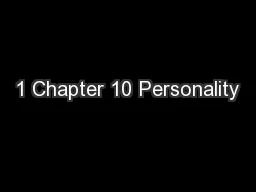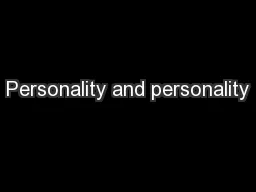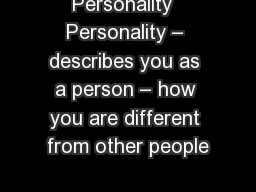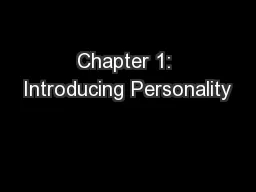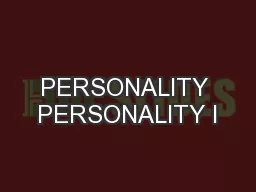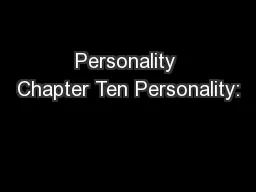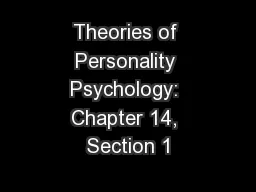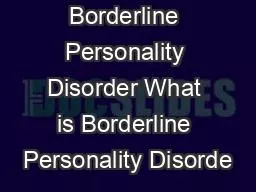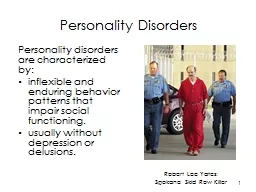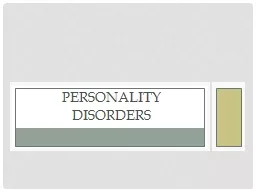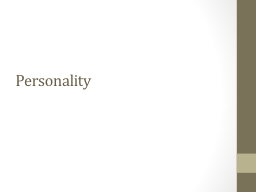PPT-1 Chapter 10 Personality
Author : faustina-dinatale | Published Date : 2018-10-29
2 Chapter Preview Psychodynamic Perspectives Humanistic Perspectives Trait Perspectives Personological and Life Story Perspectives Social Cognitive Perspectives
Presentation Embed Code
Download Presentation
Download Presentation The PPT/PDF document "1 Chapter 10 Personality" is the property of its rightful owner. Permission is granted to download and print the materials on this website for personal, non-commercial use only, and to display it on your personal computer provided you do not modify the materials and that you retain all copyright notices contained in the materials. By downloading content from our website, you accept the terms of this agreement.
1 Chapter 10 Personality: Transcript
2 Chapter Preview Psychodynamic Perspectives Humanistic Perspectives Trait Perspectives Personological and Life Story Perspectives Social Cognitive Perspectives Biological Perspectives Personality Assessment. A person does not n eed to have all of these symptoms to have the personality disorder What is the difference between OCPD and OCD People with OCD have insight meaning they are awar e that their unwanted thoughts are unreasonable People with OCPD th Jessica . Mulford. &. Marisa Hawkins . A vignette of Julian Smith . A vignette of Julian Smith. Julian thought since he was the one to put the waffles on his plate, they were his because he is the only one who is important in his mind. . disorders. Personality. Enduring . pattern of feeling thinking . and behavior . that make individual unique person. Elements of personality. Since early age. Consistent over time. Recognized by friends. Traits – the terms we use to describe yourself and others.. #1 - Social Cognitive Theory. Interaction of three factors. Cognitive-personal factors. • cognitive factors. • Include our beliefs, expectations, values, intentions, and. Learning Objectives. After reading this chapter, you should be able to do the following:. Define . personality . and explain the personality concept in psychology. Describe how personality can be approached from the standing of knowledge . nner . psychological characteristic . that reflect how a person . responds. to his/her environment.. Inner characteristics -can be specific personal . qualities, attributes, traits, mannerisms . that distinguish one individual from others. Refers to an individual’s . unique and relatively consistent pattern of thinking, feeling, and . behaving. Personality . theory: . Describes . and . explains . how people are similar, how they are different, and why every individual is . What is Personality?. Read “A Day in Life” on page 321. Would. Hannah do something like that?. The answer to that question relies on our perception of Hannah’s personality. When people think of personality, they often think of the most striking element of that personality, like having an “assertive personality” or an “artistic personality”. National Instituteof Mental HealthWhat are the signs and symptoms People with borderline personality disorder may experience mood swings and may display uncertainty about how they see themselves and t inflexible and enduring behavior patterns that impair social functioning. . usually without depression or delusions.. Robert Lee Yates: . Spokane Skid Row Killer. Personality Disorders. Broken down into Clusters:. People with personality disorders have . formed peculiar and unpleasant personality patterns. . For example, some are very secretive, some very self-centered and selfish, some suspicious all the time. . DSM-IV lists 10 separate personality disorders, with an average prevalence of 1-2%. Three clusters: anxious-fearful, odd-eccentric, and dramatic-impulsive. Concern:. . Categorical vs. Dimensional (DSM-V)?. Personality D. isorders. John Oldham, . M.D.. Past . APA . president, member Personality Disorders Work Group. 1. “from . the beginning of the development process for DSM-5, the personality disorders were identified as a place where we needed to move beyond the categorical diagnostic system of discrete disorders in DSM-IV toward a more dimensional . %). In this section of the course, students explore major theories of how humans . develop enduring . patterns of behavior and personal characteristics that influence how . others relate . to them. The unit also addresses research methods used to assess personality.
Download Document
Here is the link to download the presentation.
"1 Chapter 10 Personality"The content belongs to its owner. You may download and print it for personal use, without modification, and keep all copyright notices. By downloading, you agree to these terms.
Related Documents

